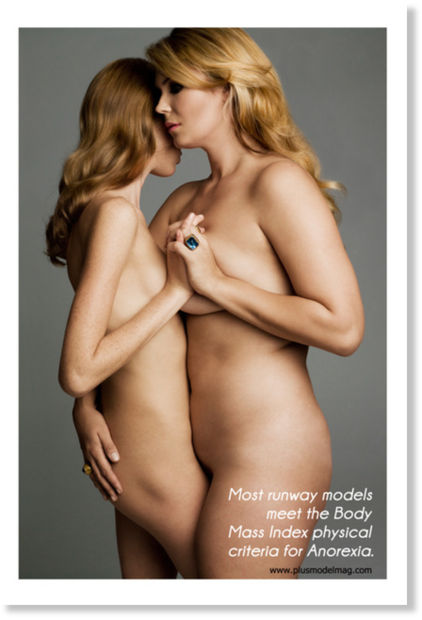
© nsfwThe high fashion model on the left looks like an inmate of a concentration camp.
A size 6 is now plus size in the fashion world, and most runway models meet the physical criteria for anorexia, according to a report that offers shocking insight into the disparity between models and the real-life women they are purporting to represent.
In the January issue of
PLUS Model Magazine, plus size model Katya Zharkova and a straight size model are seen in the nude in an attempt to "open the minds of the fashion industry," which is stepping further away from reality, according to
PLUS founder and editor-in-chief, Madeline Figueroa Jones.
The magazine reveals that some of today's plus size models are wearing the same size as models Christie Brinkley, Paulina Porizkova and Cindy Crawford at the height of their fame in the 1990s. Zharkova, 28, wears a size 14.
The photos appear alongside statistics about today's sometimes dangerously thin straight size models and the continuously shrinking frames of plus size models. Among the revelations:
"Twenty years ago the average fashion model weighed 8 percent less than the average woman. Today she weighs 23 percent less" and "most runway models meet the Body Mass Index physical criteria for Anorexia."
When Jones first saw the images, shot by photographer Victoria Janashvili, her reaction was immediate and emotional.
"I nearly cried," she told Fox411.com. "The images were submitted to other mainstream magazines and while they loved what they were seeing, they would not publish them. When they came to me, there was no hesitation on my part. I knew this would be amazing for people to see and that if we added the correct statistics, the impact would be powerful."
Click here to see the full editorial from PLUS Model magazine.
And powerful it was. When
PLUS model magazine published a blog post, boldly titled "
Plus Size Bodies, What Is Wrong With Them Anyway," it spread like wildfire.
The post asks why the fashion world is afraid to cater to plus size women in advertising, but is willing to accept their dollars.
"This is not about healthy vs. non-healthy women," Jones tells Fox411. "Because if that was so, most of the models on the runway in New York and Paris would not be walking. Not eating for days at a time can't be healthy. But I don't see anyone proclaiming how unhealthy it is and yanking them off the runway and denying them fashion."
Jones added that the feature is simply about "those plus size women who do embrace their size and want to be treated, marketed to and accepted as equals."
The response to the blog post blew Jones and her team away. It received more than 300,000 hits within the first days of being published, as well as more than 7,000 Facebook shares and more than 1,000 on Twitter.
"The statistics and photos in this article have had a global impact," Tulin Reid, Executive Marketing and Creative Director of
PLUS said in a statement. "As a plus size fashion magazine, we are thrilled with the results as it expands the conversation that we have monthly between advertisers, designers, readers and the modeling industry.
"We are not advocating an unhealthy lifestyle, but the right to have as many fashion options as the next size 2, 6 or 8 woman," Jones said. "There are all sorts of epidemics right now besides obesity, which include cancer, auto immune diseases and a myriad of eating disorders."
Most of the comments on the post have offered support of the message and include shared accounts of painful shopping experiences.
Still, the response hasn't been all positive and Jones admitted that the experience was an eye-opener for her.
"I knew that we would get some backlash but I did not expect for plus size women to be compared to drug addicts," Jones said. "Some of the feedback was so bad, we couldn't even approve it for the public to see. But we want the conversation to happen because it gives us the opportunity to help them see that this is not a health issue. It's an equal rights issue."
Clothing manufactures get the same retail price for any given garment, no matter the size. And the amount of labor required to make those same garments remains pretty much the same for the full range of sizes too. But the amount of fabric it takes to make a garment can double for a plus sized woman.
As a result, the difference in profit margins from making plus sized garments to small represents many billions of dollars in the textile/fashion industries.
That's what drives the advertizing hype. It's all about the money. And they don't give a damn for the health of their customers.
As for me, I am far more attracted to a confident women who's comfortable in her skin than to one who has bought into all the fashion industry hype, and is suffering from all the health issues that go along with habitually starving herself.